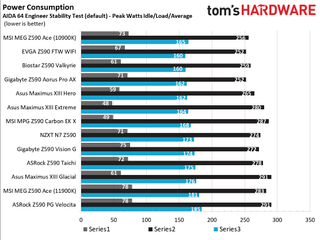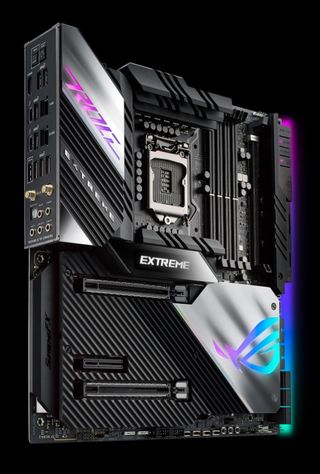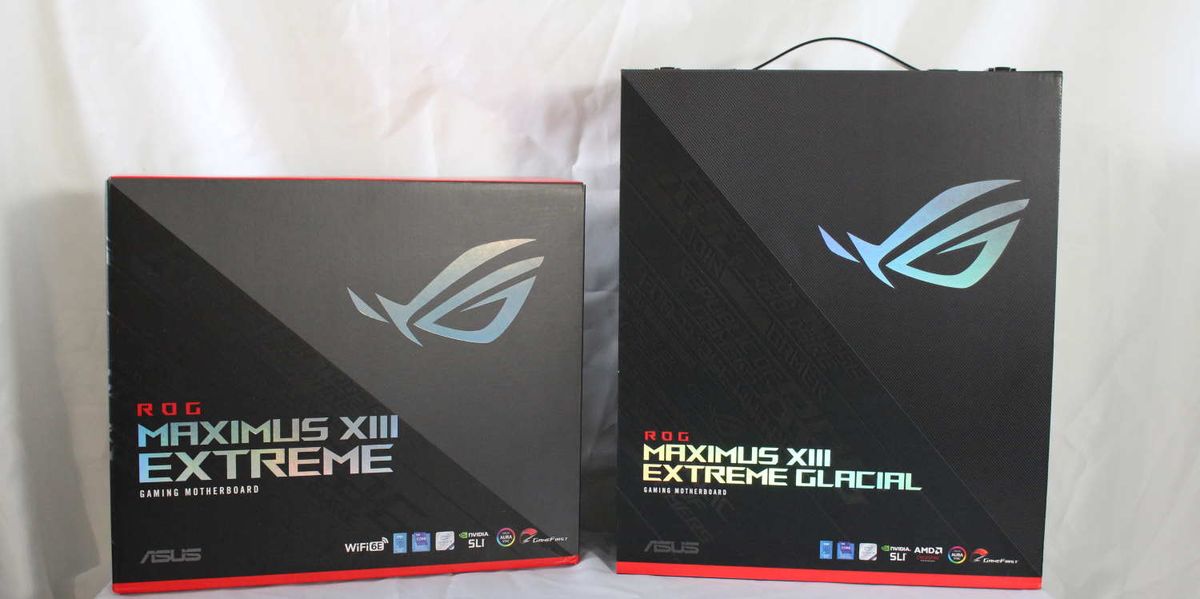Why you can trust Tom's Hardware
Benchmark Results
Our standard benchmarks and power tests are performed using the CPU’s stock frequencies (including stock Thermal Velocity Boost), with all power-saving features enabled. Optimized defaults are set in the BIOS and the memory set using the XMP profiles. For this baseline testing, Windows is set to the balanced power plan.
Synthetic Benchmarks
Synthetics are a great tool to figure out if a board runs out of spec, as identical settings should produce similar performance results. Advanced memory timings are the one place where motherboard makers can still optimize for either stability or performance, though, and those settings can impact some testing.





















Performance overall between the two boards in our synthetic benchmarks was about average for each. The Extreme tended to run on the slower side, while the water-cooled Glacial ran on the higher side. In all, it would be difficult to tell these apart from just the synthetic benchmarks.
Timed Applications




Starting with LAME testing, our Extreme boards were on the slower side of average at stock coming in at 11.51 and 11.53 seconds (Extreme and Glacial, respectively). In the Corona tests, the air-cooled Extreme took 85 seconds to complete (again, the slower side of average), while the Glacial was one of the fastest at 82 seconds.
3D Games and 3DMark




We’ve recently updated our game tests to F1 2020 and Far Cry: New Dawn. The games run at 1920x1080 resolution using the Ultra preset. As the resolution goes up, the CPU tends to have less of an impact. The goal with these settings is to determine if there are differences in performance at the most commonly used resolution with common settings people use or strive for.
In our gaming/graphics testing, both the Extreme and Extreme Glacial did well, scoring average or above average results in the 3DMark tests and actual games tests. We saw nothing out of the ordinary here.
Power Consumption / VRM Temperatures

We used AIDA64’s System Stability Test with Stress CPU, FPU and Cache enabled for power testing, using the peak power consumption value. With Rocket Lake, we need to disable AVX-512 instruction sets otherwise, temperatures are out of control at stock speeds on some boards. The wattage reading is from the wall via a Kill-A-Watt meter to capture the entire ecosystem. The only variable that changes is the motherboard; all other parts are the same.
Power consumption values on the air-cooled Extreme were just below average at 164W. Idle use was the lowest we’ve seen at 48W, while load reached 280W. The Extreme Glacial with all of its watercooling parts (pump and additional fan) were on the higher side of average at 181W. Idle was also low here at 61W, while load power use was a tie for the highest at 291W.






Asus’s incredibly robust 100A VRMs easily handled our CPU at stock and while overclocked. The VRMs ran well within specification during both sets of tests. On the air-cooled Extreme, temperatures peaked just over 50 degrees Celsius at stock and around 52 degrees Celsius overclocked. Meanwhile, the water-cooled Glacial reached a cool 40 degrees Celsius at stock and nearly 42 degrees Celsius while overclocked. As expected, the water-cooled bits run cooler than the passive air-cooled VRM. Making this more impressive is the fact that the Glacial used a 3x120mm radiator tasked with cooling the CPU, VRMs and chipset in our testing. Both motherboards and the overbuilt VRM won’t have any trouble handling your ambient or even sub-ambient overclocking adventures.
Overclocking
Overclocking these boards was as easy as any other motherboard so far. Asus’ BIOS puts all of the options you need at your fingertips so you don’t have to move to different sections to find the option you’re looking for. VDroop was managed well using the LLC7 setting. This allowed a slight drop from what we set in the BIOS. If we used LLC4 as recommended in the BIOS, the vdroop was significant.
When overclocking the i9-11900K, we decided to do so by testing without AVX-512 instructions. When you unlock all of the power limits, you’re thermally limited, with the CPU reaching 100 degrees Celsius in several seconds. Since every board is different in following (or not) Intel specifications, we’ve removed that variable. The bottom line is that if you need to use these instructions, you’ll need to set a significant offset compared to non-AVX-512 loads. To that end, we settled on a 5.1 GHz overclock at around 1.3V. Our CPU uses around 225W in this configuration, which lands between stock power use (195W) and AVX-512 power use (~265W) and is the end of the line due to thermal constraints.


On the memory front, both Extremes ran our DDR4 3600 sticks at a 1:1 ratio (Gear 1) and didn’t have any issues with the DDR4 4000 kit. Both boards were right around average in the AIDA bandwidth and latency tests. You have nothing to worry about here.
Final Thoughts
Asus’ ROG Maximus XIII Extreme and Extreme Glacial are truly flagship-class motherboards. From the overbuilt 100A VRM, dual ultra-fast Thunderbolt 4 ports, 10 GbE NIC, watercooling monitoring capabilities, high-end audio solution, premium appearance, and a custom water block on the Glacial, there’s a lot to love for the $899.99 and $1499.99 price points. The question becomes, is it worth it for you to buy and build your system around. While that is a subjective question, both boards are a one-stop shop offering comprehensive control over your system with some of the best hardware currently available on the platform.
Performance compared to the other Z590 boards we’ve tested flanked average on both sides. On one hand, the Extreme was slightly below average overall, while the Extreme Glacial was slightly above average. That said, the variance from average either way wasn’t much. Gaming performance was above average, scoring and playing well in our tests. In the end, you’d be hard-pressed to tell the difference between the two boards or any others we’ve tested so far. Memory testing went well with both boards running our DDR4 3600 kit at 1:1 and had no issues with our middling DDR4 4000 kit (running at 1:2). With the overbuilt VRMs (and water cooling on the Glacial), both boards handled overclocking our Intel Core i9-11900K without issue.

In the end, the Asus ROG Maximus XIII Extreme and Extreme Glacial are incredibly well-built motherboards. From the 100A MOSFETs to flagship-class audio, five M.2 sockets, high-end looks, ultra-fast Thunderbolt 4 and USB 3.2 Gen2x2 ports, included DACs and fan controller modules, plus the ability to monitor and control your water cooling loop, it all makes this an incredible board for a high-end build. The Glacial takes that up a notch and includes a custom EK waterblock to keep the CPU, VRM, and chipset cool. Your wallet will feel a lot lighter at $999.99 for the Extreme and $1499.99 for the Extreme Glacial. But when it’s all said and done, you’ll have one of the most comprehensive and well-built boards for your Z590 based system if you choose one of these Asus flagships.
As far as improvements go, what can you say? The price point is high on both boards and we all want flagship parts and their functionality within reach of more people. Outside of that, my biggest complaint on the Extreme is the minimal space to access the top PCIe slot’s locking mechanism. I needed to use a screwdriver to reach it. Outside of that, the only thing worth mentioning (and it’s pretty subjective) is that some may not like the silver theme on the Glacial.
There is some competition in the flagship space, with most major board partners throwing something on the wall around the $1000 price point. MSI has the MEG Z590 Godlike ($999.99) and Gigabyte offers up the Z590 Aorus Extreme ($849.99). Those out of the way, ASRock’s flagship part, the Z590 OC Formula ($579.99), is priced quite a bit less and is focused more on extreme overclocking (though it’s still a very capable ‘gaming’ motherboard) than on premium luxury. Perhaps we’ll see a Z590 Aqua later down the road. The most significant difference between these boards, outside of price, is the appearance and feature set. All of these boards have robust power delivery and support high memory overclocking. But only the Asus board offers five total M.2 sockets. All of these boards have some form of water cooling monitoring capabilities as well.
The water-cooled Extreme Glacial also has competition in this space with the Gigabyte Z590 Aorus Extreme Waterforce ($1599.99). Like the Glacial, the Waterforce version is the Extreme with a custom water block included (at an even higher price point). For those who may not like the silver theme on Glacial, the Waterforce board is all black and is your only choice in this class. Between the two, the Glacial supports more M.2 storage and uses the latest generation flagship audio codec, whereas the Aorus Extreme uses last-gen flagship audio. While there are other, more subtle, differences, those are the two that stick out.
MORE: Best Motherboards
MORE: How To Choose A Motherboard
MORE: All Motherboard Content

Joe Shields is a Freelance writer for Tom’s Hardware US. He reviews motherboards.

You can buy this AOC 27-inch Mini-LED 2K gaming monitor for just $249 at Amazon

Thunderbolt 5 dock with MXM graphics, M.2 SSD slot, lots of I/O debuts at CES – J5Create's device offers RTX 3060 and RX 7600M variants for about $1,400

Tetris packed inside a PDF file to run in any PC browser — Pdftris runs from a 60KB PDF
-
tresnugget Instead of testing at optimized default settings, you should consider testing while normalizing bclk and power limits. It's well known that motherboard manufacturers boost performance by giving those a bump so it would be a better comparison of actual performance differences by manually entering the stock values for bclk, pl1, pl2, tau, etc. This is how GN tests but they don't test anywhere near as many motherboards as you guys.Reply
